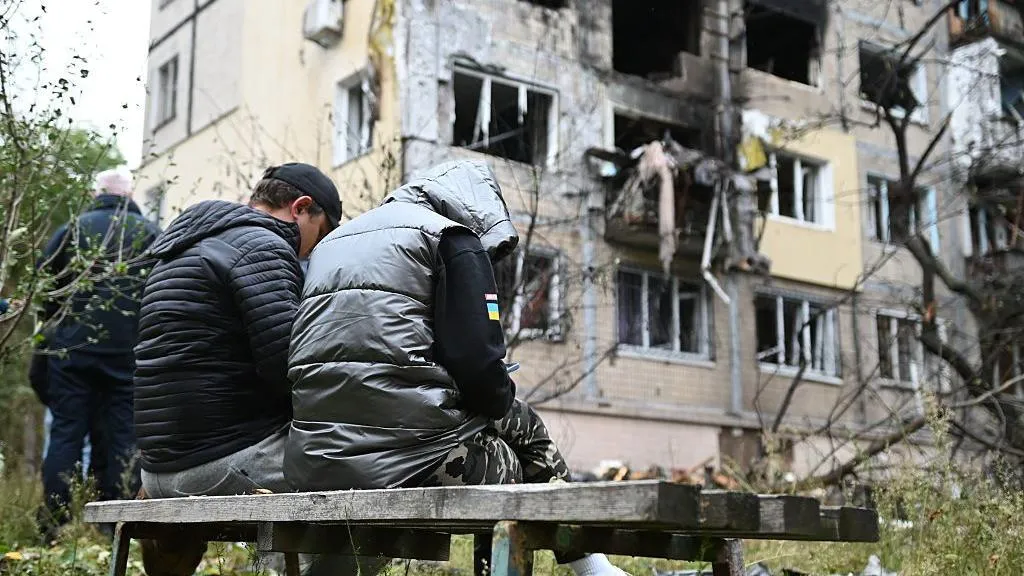
 Getty Images
Getty ImagesThe US is considering a request by Ukraine for long-range Tomahawk missiles, US Vice-President JD Vance has said.
However, Vance added President Donald Trump would be making "the final determination" on the matter.
Kyiv has long been calling for its Western partners to provide it with weapons that could hit major Russian cities far from the front line, arguing that they would help Ukraine seriously weaken Russia's military industry and bring the war to an end.
"If the cost of continuing the war for Moscow is too high, it will be forced to start peace talks," deputy defence minister Ivan Havryliuk told the BBC.
Kremlin spokesman Dmitry Peskov played down Vance's suggestion, saying there was "no panacea that can change the situation on the front for the Kyiv regime."
"Whether it's Tomahawks or other missiles, they won't be able to change the dynamic," he added.
Tomahawk missiles have a range of 2,500 km (1,550 miles), which would put Moscow within reach for Ukraine.
While Vance remained ambivalent about Ukraine's request for Tomahawks in his remarks on Sunday, the US special envoy to Ukraine, Keith Kellogg, seemed to suggest Trump had already authorised strikes deep into Russian territory.
Asked on Fox News whether Washington had allowed Kyiv to carry out long-range strikes within Russia in specific instances, Kellogg said: "The answer is yes, use the ability to hit deep, there are no such things as sanctuaries."
Vance and Kellogg's comments match the US administration's recent change of tone in regard to the war.
After repeatedly expressing scepticism that Ukraine could continue to hold its own against Russia, last week Trump said Kyiv could "win all of Ukraine back in its original form" – a shift that reportedly even surprised Ukraine's Volodymyr Zelensky.
Trump is known to have been irritated by Russian President Vladimir Putin's surface willingness to discuss ending the war versus the reality of Moscow's persistent bombardments of Ukraine's cities.
On Sunday, a massive 12-hour strike involving hundreds of drones and nearly 50 missiles left four people dead in Kyiv and at least 70 injured.
Ukraine's Havryliuk told the BBC Russia was only going to further increase the intensity and severity of its aerial attacks.
 Ukrainian Ministry of Defence
Ukrainian Ministry of DefenceTo protect its skies from ballistic missiles, Kyiv has asked its Western partners for at least 10 units of Patriot surface-to-air defence systems which can detect and intercept oncoming missiles.
Asked whether the Patriot systems Trump promised over the summer were forthcoming, Havryliuk declined to be drawn into specifics but said there was "some movement in this direction".
The more drones and missiles are fired by Russia, the harder it is for Ukraine to intercept them.
Earlier this month Moscow fired a record number of more than 800 drones and missiles – the highest since the start of the full-scale invasion of Ukraine in February 2022.
Inevitably, during such large-scale attacks the interception rate drops.
Out of the hundreds of drones used in Sunday's attack, 31 managed to hit their targets. According to President Zelensky, the majority were residential buildings and civilian facilities such as a cardiology centre in Kyiv.
As well as being more frequent and intense, aerial attacks are also becoming more dangerous as Moscow is using new and more advanced drones to break through Ukraine's air defence systems, Havryliuk said.
When Iranian-made Shahed drones were used for the first time in 2023, "they were easy to jam using our electronic warfare systems", he explained.
"Today, they use 16-channel antennas in order to pass through our jamming zones."
Havryliuk also believes they would be a way for Ukraine to stop Russian drones before they reach EU countries.
"Strengthening our air defence system is an investment into security of the entire Europe," he said, referring to the recent incursion of Russian drones into Polish airspace.
He added that it would disrupt "Putin's plans to constantly scare Europe".
Earlier this year the Trump administration approved a new mechanism which sees European allies purchase US-made weapons for Ukraine. So far, several European countries and Canada have collectively pledged $2bn (£1.5bn).
While some of the weapons bought under the scheme have already arrived in Ukraine, Havryliuk said, the process is slower than before.
Time is a precious commodity in Ukraine, and in the last three and a half years of war Kyiv has developed a thriving defence industry, significantly increasing its production of drones, artillery shells, artillery systems and armoured vehicles.
Ukraine now produces almost 100% of First Person View (FPV) drones it needs and up to 40% of the front line's demand for other weapons, Havryliuk said.
On Monday Zelensky said Ukraine would continue to focus on domestically produced drones and missiles with long-range capabilities.
But until it can step up production of weapons Kyiv will remain largely dependent on its allies to provide the air defence systems it needs.
Ukraine is hoping that better protection of its cities with air defence systems combined with long-range weapons able to hit Russian targets will help bring Moscow to the negotiating table.
"Only together with our partners can we stop the Russian terror in the sky," Havryliuk said.